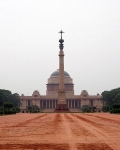Rashtrapati Bhawan
Archaeology »
Archaeological Monuments » Rashtrapati Bhawan
Rashtrapati Bhawan - India
Rashtrapati Bhawan is located in New Delhi, Delhi.
Rashtrapati Bhawan monument was established on 1931.
Primary threats to Rashtrapati Bhawan :
The splendor of the Rashtrapati Bhavan is multi-dimensional. It is a vast mansion and its architecture is breathtaking.
Historical facts of Rashtrapati Bhawan :
- Rashtrapati Bhavan, located in New Delhi, India, is the official residence of the President of India. Spread across a vast area, it is a magnificent structure that stands as a symbol of India's rich history and architectural heritage. Let's explore some historical facts about Rashtrapati Bhavan.
- Architectural Marvel :
Rashtrapati Bhavan was designed by the renowned British architect Sir Edwin Lutyens and his associate, Sir Herbert Baker. The construction of this grand building began in 1912 and was completed in 1929. It covers an area of 330 acres and has a total of 340 rooms. The architectural style combines elements of Indo-Saracenic, Mughal, and European aesthetics.
- Former Viceroy's House :
Originally, Rashtrapati Bhavan was intended to be the residence of the British Viceroy of India during the colonial era. Lord Irwin, the Viceroy of India at the time, laid the foundation stone in 1912. However, with the transition of India to a republic in 1950, it became the official residence of the President of India.
- Shifting of Capital :
During the British Raj, Calcutta (now Kolkata) served as the capital of India. However, in 1911, the decision was made to shift the capital to Delhi. This led to the planning and construction of a new administrative center, which included the Rashtrapati Bhavan as its centerpiece.
- Majestic Architecture :
Rashtrapati Bhavan is an architectural masterpiece with four floors and a central dome that rises to a height of 145 feet. The dome is visible from a distance and adds to the grandeur of the building. The main entrance, known as the Forecourt, features the Jaipur Column, which was presented as a gift from the Maharaja of Jaipur.
- Mughal Gardens :
Rashtrapati Bhavan is famous for its beautiful Mughal Gardens, spread over 15 acres. These gardens were designed by Sir Edwin Lutyens and include terraced lawns, flower beds, water channels, and numerous varieties of flowers. The gardens are open to the public during the spring season, showcasing their vibrant beauty.
- Changing of the Guard :
Similar to the Buckingham Palace in London, Rashtrapati Bhavan has a Changing of the Guard ceremony. The ceremony takes place every Saturday morning and is accompanied by a military band. It is a spectacle that attracts tourists and visitors who wish to witness the pomp and pageantry.
- Heritage Museum :
Rashtrapati Bhavan houses a Heritage Museum that provides insights into the history, architecture, and art associated with the building. The museum displays various artifacts, photographs, and documents that depict the evolution of the Bhavan from its early stages to its present form.
- Ceremonial Functions :
Rashtrapati Bhavan serves as a venue for numerous ceremonial functions and events. The most notable among these is the Presidential Swearing-in Ceremony, where the newly elected President of India takes the oath of office. It is a significant event that marks the beginning of a new presidential term.
- Open to the Public :
While Rashtrapati Bhavan is the official residence of the President, certain parts of the complex are open to the public. Visitors can explore the Mughal Gardens, the Rashtrapati Bhavan Museum, and attend the Change of Guard ceremony. These initiatives aim to promote transparency and provide citizens with a glimpse of their country's heritage.
- Symbol of India's Democracy :
Rashtrapati Bhavan stands as an iconic symbol of India's democratic values and the country's progress. It has witnessed the transition from colonial rule to an independent republic and has been the residence of India's Presidents since its inception. It represents the power, grace, and sovereignty of the Indian nation.
- In conclusion, Rashtrapati Bhavan is a remarkable architectural marvel that holds historical significance as the residence of India's President. Its grandeur, cultural heritage, and the events that take place within its walls make it a cherished landmark in the heart of New Delhi, reflecting the rich history and democratic spirit of India.

